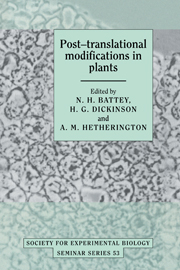Book contents
- Frontmatter
- Contents
- List of contributors
- List of abbreviations
- Preface
- Some roles of post-translational modifications in plants
- Signal transduction and protein phosphorylation in bacteria
- Roles of protein phosphorylation in animal cells
- The significance of post-translational modification of proteins by phosphorylation in the regulation of plant development and metabolism
- Post-translational modification of chloroplast proteins and the regulation of protein turnover
- Purification of a small phosphoprotein from chloroplasts and characterisation of its phosphoryl group
- Use of synthetic peptides to study G proteins and protein kinases within plant cells
- Activation of membrane-associated protein kinase by lipids, its substrates, and its function in signal transduction
- Distribution and function of Ca2+-dependent, calmodulin-independent protein kinases
- Phosphorylation of the plasma membrane proton pump
- The regulation of phosphoenolpyruvate carboxylase by reversible phosphorylation
- Protein phosphorylation and circadian rhythms
- Control of translation by phosphorylation of mRNP proteins in Fucus and Xenopus
- Regulation of plant metabolism by reversible protein (serine/threonine) phosphorylation
- Detection, biosynthesis and some functions of glycans N-linked to plant secreted proteins
- Biosynthesis, intracellular transport and processing of ricin
- Post-translational processing of concanavalin A
- The role of cell surface glycoproteins in differentiation and morphogenesis
- Ubiquitination of proteins during floral development and senescence
- Index
Use of synthetic peptides to study G proteins and protein kinases within plant cells
Published online by Cambridge University Press: 06 July 2010
- Frontmatter
- Contents
- List of contributors
- List of abbreviations
- Preface
- Some roles of post-translational modifications in plants
- Signal transduction and protein phosphorylation in bacteria
- Roles of protein phosphorylation in animal cells
- The significance of post-translational modification of proteins by phosphorylation in the regulation of plant development and metabolism
- Post-translational modification of chloroplast proteins and the regulation of protein turnover
- Purification of a small phosphoprotein from chloroplasts and characterisation of its phosphoryl group
- Use of synthetic peptides to study G proteins and protein kinases within plant cells
- Activation of membrane-associated protein kinase by lipids, its substrates, and its function in signal transduction
- Distribution and function of Ca2+-dependent, calmodulin-independent protein kinases
- Phosphorylation of the plasma membrane proton pump
- The regulation of phosphoenolpyruvate carboxylase by reversible phosphorylation
- Protein phosphorylation and circadian rhythms
- Control of translation by phosphorylation of mRNP proteins in Fucus and Xenopus
- Regulation of plant metabolism by reversible protein (serine/threonine) phosphorylation
- Detection, biosynthesis and some functions of glycans N-linked to plant secreted proteins
- Biosynthesis, intracellular transport and processing of ricin
- Post-translational processing of concanavalin A
- The role of cell surface glycoproteins in differentiation and morphogenesis
- Ubiquitination of proteins during floral development and senescence
- Index
Summary
Introduction
The recent advances in synthetic peptide technology have presented new opportunities to study plant signal transduction. In particular, the use of synthetic peptides has the advantage that relatively large quantities (10–100 mg) of pure site-specific reagents can be prepared with relative ease and can be utilised for a number of purposes. The most evident use is perhaps as synthetic antigens, where it is impossible or impracticable to isolate sufficient pure protein to permit immunisation. Such anti-peptide antibodies have proved extremely useful in identification of the plant homologues of their animal G protein (mainly Gα subunit) counterparts. However, there are other areas where synthetic peptides can be usefully employed. Important information concerning the substrate-specificity of protein kinases can be gained from observing the relative efficiency with which members of a series of peptides, each differing slightly in structure, can act as phosphate acceptors for the target kinase. Additionally, synthetic peptides can be used as direct mimics of protein structure in order to probe protein : protein interaction. For example, in our work we have utilised a peptide of moderate length (15 residues), whose sequence corresponds to a domain within the Gα subunit which is known to specify G-protein–receptor interaction, as an affinity ligand for receptor isolation. In other work, peptides that represent sections of the petD gene product have been used to delineate the domains of the petD protein, which may be important in LHC II kinase regulation.
- Type
- Chapter
- Information
- Post-translational Modifications in Plants , pp. 91 - 108Publisher: Cambridge University PressPrint publication year: 1993

